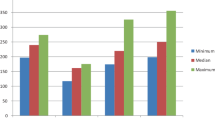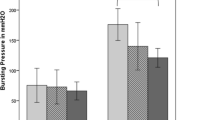Abstract
To study the possible effects of diclofenac sodium on intestinal anastomoses, 48 rabbits were submitted to surgery consisting of two single-layer ileal anastomoses performed with separate propylene 5-0 sutures. The animals were divided at random into two groups (test and control). The animals in the test group were given intramuscular injections of diclofenac sodium at the dose of 3 mg/ kg body weight at 24-hour intervals, and the control animals were given injections of an identical amount of 0.9 percent saline. The animals were sacrificed on the 3rd, 7th, and 14th postoperative days for macroscopic evaluation of the peritoneal cavity and of the anastomoses, tensile strength measurement, hydroxyproline determination, and histopathologic examination. The following results were observed: anastomotic dehiscence followed by peritonitis and death in five test animals (20.83 percent) and no control animals; decreased anastomotic tensile strength on the 7th day in test animals (P<0.05); delayed acute inflammatory response and onset of fibroblast proliferation in the test group; and similar hydroxyproline levels in both groups. On the basis of the results obtained, we conclude that diclofenac sodium had a negative effect on intestinal anastomotic healing.
Similar content being viewed by others
References
Fielding LP, Stewart-Brown S, Blesovsky L, Kearney G. Anastomotic integrity after operations for large-bowel cancer: a multicentre study. Br Med J 1980;281:411–4.
Carrico TJ, Mehrhof AI, Cohen IK. Biology of wound healing. Surg Clin North Am 1984;64:721–33.
Aszodi A, Ponsky JL. Effects of corticosteroid on the healing bowel anastomosis. Am Surg 1984;50:546–8.
Gonzales E, Capurro Robles D, Gonzales LL,et al. Efectos de los corticoides en anastomoses colónicas en ratas. Rev Argent Cir 1984;46:290–2.
Mantovani M, Leonardi LS, Alcântara FG. EvoluÇÃo da cicatrizaÇÃo em anastomoses do intestino grosso em condiÇÕes de normalidade e sob aÇÃo de drogas imunossuppressoras: estudo comparativo em cÃes. Rev Paul Med 1979;94:118–26.
Martins A Jr. CicatrizaÇÃo de anastomoses intestinais sob aÇÃo da dexametasona: trabalho experimental no intestino delgado do cÃo. Master's thesis. Faculty of Medicine of RibeirÃo Preto, University of SÃo Paulo, 1987.
Rosenberg D, Nasser A, Behmer DA, Regen IB, Oksman PV, Deutsch CR. AÇÃo da betametasona nas anastomoses intestinais em um e dois planos de sutura com diferentes materiais. Rev Paul Med 1976;87:98–106.
Brunius U, Zederfeldt B. Effects of antiinflammatory treatment on wound healing. Acta Chir Scand 1965;129:462–7.
Fang C, Alexander JW, MacMillan BG, Austin LS. Failure of topical prostaglandin inhibitors to improve wound healing following deep partial-thickness burns. J Trauma 1983;23:300–4.
Gadacz T, Menguy RB. Effects of anti-inflammatory drug oxyphenbutazone on the rate of wound healing and the biochemical composition of wound tissue. Surg Forum 1967;18:58–60.
Lee KH. Studies on the mechanism of action of salicylates. III. Effect of vitamin A on the wound healing retardation action of aspirin. J Pharm Sci 1968;57:1238–40.
Lee KH, Tong TG. Mechanism of action of salicylates. VIII. Effect of topical application of retinoic acid on wound-healing retardation action of a few anti-inflammatory agents. J Pharm Sci 1970;59:1036–8.
Ballantyne GH. The experimental basis of intestinal suturing: effect of surgical technique, inflammation, and infection on enteric wound healing. Dis Colon Rectum 1984;27:61–71.
Carril CF. Anastomoses intestinais. Métodos invaginantes e métodos por aposiÇÃo em mesmo alinhamento. Estudo experimental comparativo com apresentaÇÃo de um processo original. “Livre DocÊncia” thesis, Faculty of Medicine of RibeirÃo Preto, University of SÃo Paulo, 1970.
Stegemann H, Stalder K. Determination of hydroxyproline. Clin Chim Acta 1967;18:267–73.
Medugorac I. Collagen content in different areas of normal and hypertrophied rat myocardium. Cardiovasc Res 1980;14:551–4.
Brennan SS, Foster ME, Morgan A, Leaper DJ. Prostaglandins in colonic anastomotic healing. Dis Colon Rectum 1984;27:723–5.
Klein L, ChandraRajan J. Collagen degradation in rat skin but not in intestine during rapid growth: effect on collagen types I and III from skin. Proc Natl Acad Sci U S A 1977;74:1436–9.
Ku EC, Wasvary JM, Cash WD. Diclofenac sodium (GP 45840, Voltaren), a potent inhibitor of prostaglandin synthetase. Biochem Pharmacol 1975;24:641–3.
Ku EC, Kothari H, Lee W, Kimble EF, Liauw LH. Effects of diclofenac sodium on the arachidonic acid metabolism. Agents Actions (Suppl) 1985;17:189–93.
Author information
Authors and Affiliations
About this article
Cite this article
Batista de Sousa, J., Garcia Soares, E. & Aprilli, F. Effects of diclofenac sodium on intestinal anastomotic healing. Dis Colon Rectum 34, 613–617 (1991). https://doi.org/10.1007/BF02049903
Issue Date:
DOI: https://doi.org/10.1007/BF02049903




